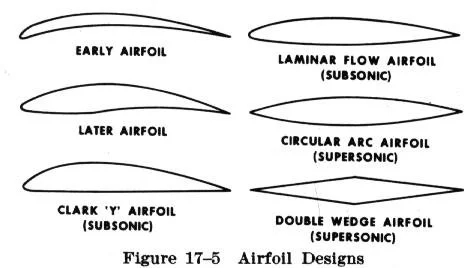How Airfoils (Wings) Generate Lift
Airfoils are shapes designed to create a force, typically lift, when it interacts with a fluid such as air. Airfoils achieve forces such as lift by manipulating airflow as it moves over and under the airfoil’s surface. The shape is specifically designed to create an aerodynamic force specific to the aircraft’s needs.
You may notice that the supersonic airfoils in the diagram above all have sharp edges. Supersonic airfoils have sharp edges to reduce shockwave formation that would create wave drag. Wave drag is when an object moves through air at transonic or faster speeds, and creates shockwaves due to the compressing air around it. This occurs because air cannot move out of the way fast enough. On a more general note, airfoils work because of Bernoulli's Principle and Newton's Third Law of Motion. The curved top of the airfoil causes air to move faster over the wing relative to the air moving under the wing. This creates a pressure difference and the higher pressure under the wing generates lift. We also cannot ignore the fact that airfoils deflect air downwards at the end which creates an equal and opposite upward force to help lift the plane up.
An airfoil is made up of multiple parts. The leading edge is where the air first makes contact. Conversely, the trailing edge is where the airflow leaves the airfoil. Next, we have a chord line which is a straight line that starts at the leading edge to the trailing edge. This line is important because it is used to measure the angle of attack between the chord line and relative direction of airflow. This affects the pressure differences between air on top and below the airfoil and in turn affects the lift and drag.
Next time, I will go over how airfoils, specifically the wings of a plane, create an aerodynamic effect.

